
Respect Their Space: Dogs Have Boundaries Like Humans Do
Introduction:
Just like humans, dogs have personal boundaries. They may not speak the same language we do, but their body tells a story—one that’s just as real and just as important. Whether it’s shifting away from a stranger, hiding behind their handler, or giving a side-eye glance, these subtle behaviors are your dog’s way of saying “no, thank you.”
If those early signals are ignored, we risk damaging our dog’s trust—and in many cases, setting the stage for fear-based reactivity or even bites.
Not All Boundaries Are Barked
We often expect dogs to be obvious when they’re uncomfortable—growling, barking, snapping—but in reality, dogs usually start with very soft signals:
-
Turning their head away
-
Licking their lips
-
Yawning when not tired
-
Shaking off like they’re wet
-
Moving behind their handler
-
Avoiding eye contact
-
Lifting a paw or freezing
These aren’t random actions—they’re communication. They’re saying, “I need space,” “This is too much,” or “Please help me out of this.” When we don’t respond, a dog may feel forced to speak louder, and that’s when growls, lunges, or bites happen.
How Ignoring Boundaries Leads to Reactivity
Imagine being in a crowded room, clearly overwhelmed, and no one notices—or worse, tells you to “calm down” instead of stepping in. That’s how a dog feels when kids run up to them, strangers grab their face, or another dog charges toward them—and their owner doesn’t intervene.
Repeated exposure to these situations teaches a dog that no one is going to help them. So, they learn to handle it themselves—and that’s where reactivity develops.
Protecting their space teaches them, “I’ve got your back,” which builds emotional safety, confidence, and trust.
Be Your Dog’s Advocate in Public
Your dog can’t speak English—but you can. When you notice your dog’s body language shifting, step in before it escalates.
-
Politely ask people not to pet your dog
-
Move away from crowded spaces
-
Let your dog hide behind you if they want to
-
Say no to dogs rushing yours off-leash
-
Give your dog a break from the chaos
These aren’t just training strategies—they’re acts of protection that teach your dog they can rely on you.
Conclusion: Boundaries Build the Bond
Understanding and respecting your dog’s boundaries is one of the most powerful ways to prevent reactivity and deepen your relationship. Dogs don’t need to bark to set a boundary—and they shouldn’t have to.
When you protect your dog’s space, they learn to trust you not just as a companion, but as a confident leader. And trust is the foundation of every strong bond.
Need help learning your dog’s signals?
Book a one-on-one consultation through our Phone Book with certified trainer Ali Searles. Click the link in bio or head to DontBeBreedist.com for more info.
